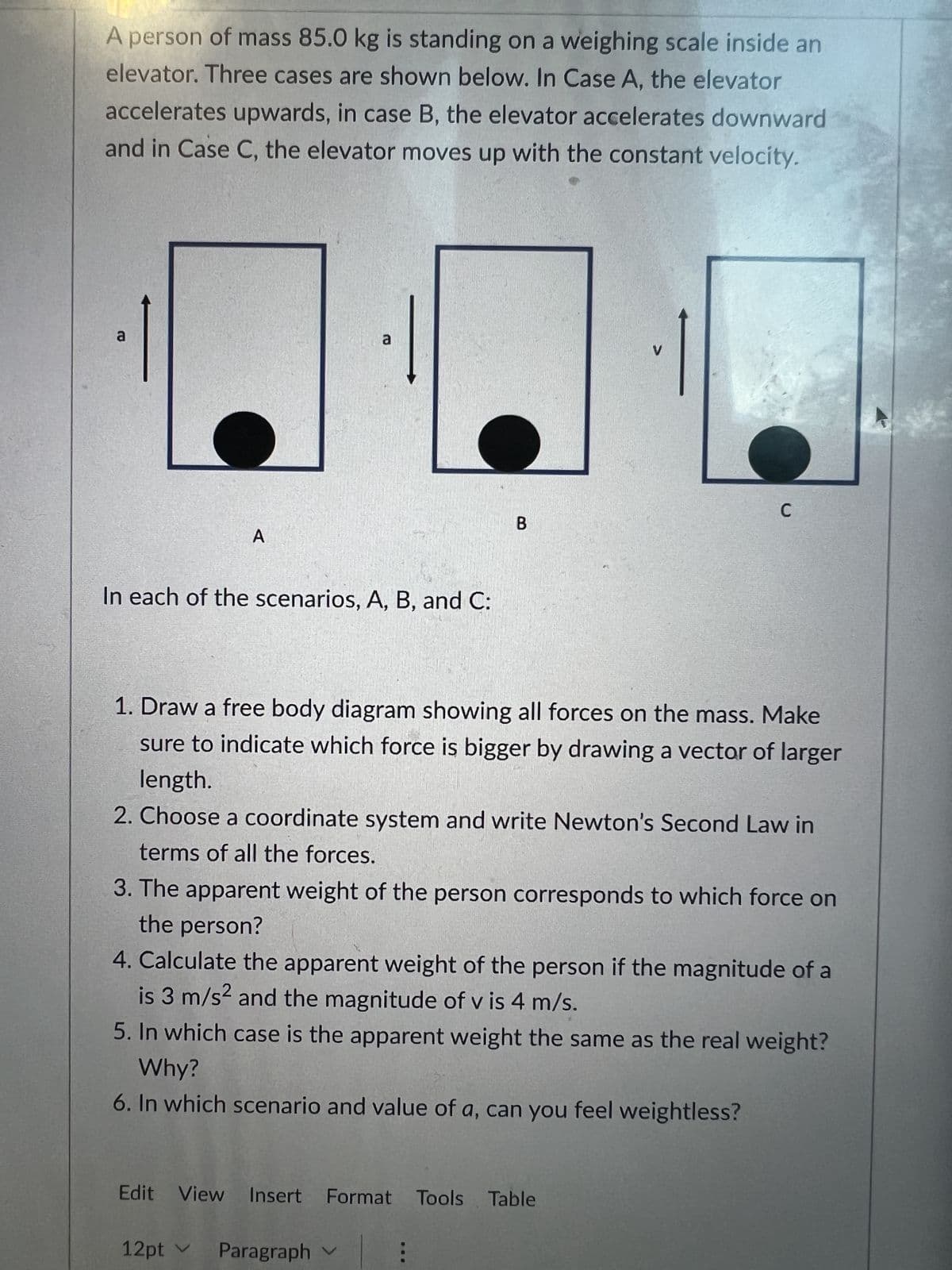A person of mass 85.0 kg is standing on a weighing scale inside an elevator. Three cases are shown below. In Case A, the elevator accelerates upwards, in case B, the elevator accelerates downward and in Case C, the elevator moves up with the constant velocity. a A In each of the scenarios, A, B, and C: B C 1. Draw a free body diagram showing all forces on the mass. Make sure to indicate which force is bigger by drawing a vector of larger length. 2. Choose a coordinate system and write Newton's Second Law in terms of all the forces. 3. The apparent weight of the person corresponds to which force on the person? 4. Calculate the apparent weight of the person if the magnitude of a
A person of mass 85.0 kg is standing on a weighing scale inside an elevator. Three cases are shown below. In Case A, the elevator accelerates upwards, in case B, the elevator accelerates downward and in Case C, the elevator moves up with the constant velocity. a A In each of the scenarios, A, B, and C: B C 1. Draw a free body diagram showing all forces on the mass. Make sure to indicate which force is bigger by drawing a vector of larger length. 2. Choose a coordinate system and write Newton's Second Law in terms of all the forces. 3. The apparent weight of the person corresponds to which force on the person? 4. Calculate the apparent weight of the person if the magnitude of a
University Physics Volume 1
18th Edition
ISBN:9781938168277
Author:William Moebs, Samuel J. Ling, Jeff Sanny
Publisher:William Moebs, Samuel J. Ling, Jeff Sanny
Chapter6: Applications Of Newton's Laws
Section: Chapter Questions
Problem 39P: A student’s backpack, full of textbooks, is hung from a spring scale attached to the ceiling of an...
Related questions
Question
show all work and steps please.

Transcribed Image Text:A person of mass 85.0 kg is standing on a weighing scale inside an
elevator. Three cases are shown below. In Case A, the elevator
accelerates upwards, in case B, the elevator accelerates downward
and in Case C, the elevator moves up with the constant velocity.
a
A
a
In each of the scenarios, A, B, and C:
B
1. Draw a free body diagram showing all forces on the mass. Make
sure to indicate which force is bigger by drawing a vector of larger
length.
2. Choose a coordinate system and write Newton's Second Law in
terms of all the forces.
3. The apparent weight of the person corresponds to which force on
the person?
12pt ✓ Paragraph
C
4. Calculate the apparent weight of the person if the magnitude of a
is 3 m/s² and the magnitude of v is 4 m/s.
5. In which case is the apparent weight the same as the real weight?
Why?
6. In which scenario and value of a, can you feel weightless?
Edit View Insert Format Tools Table
:
Expert Solution
This question has been solved!
Explore an expertly crafted, step-by-step solution for a thorough understanding of key concepts.
Step by step
Solved in 3 steps with 3 images

Knowledge Booster
Learn more about
Need a deep-dive on the concept behind this application? Look no further. Learn more about this topic, physics and related others by exploring similar questions and additional content below.Recommended textbooks for you

University Physics Volume 1
Physics
ISBN:
9781938168277
Author:
William Moebs, Samuel J. Ling, Jeff Sanny
Publisher:
OpenStax - Rice University

College Physics
Physics
ISBN:
9781938168000
Author:
Paul Peter Urone, Roger Hinrichs
Publisher:
OpenStax College

College Physics
Physics
ISBN:
9781285737027
Author:
Raymond A. Serway, Chris Vuille
Publisher:
Cengage Learning

University Physics Volume 1
Physics
ISBN:
9781938168277
Author:
William Moebs, Samuel J. Ling, Jeff Sanny
Publisher:
OpenStax - Rice University

College Physics
Physics
ISBN:
9781938168000
Author:
Paul Peter Urone, Roger Hinrichs
Publisher:
OpenStax College

College Physics
Physics
ISBN:
9781285737027
Author:
Raymond A. Serway, Chris Vuille
Publisher:
Cengage Learning

Glencoe Physics: Principles and Problems, Student…
Physics
ISBN:
9780078807213
Author:
Paul W. Zitzewitz
Publisher:
Glencoe/McGraw-Hill

Physics for Scientists and Engineers, Technology …
Physics
ISBN:
9781305116399
Author:
Raymond A. Serway, John W. Jewett
Publisher:
Cengage Learning